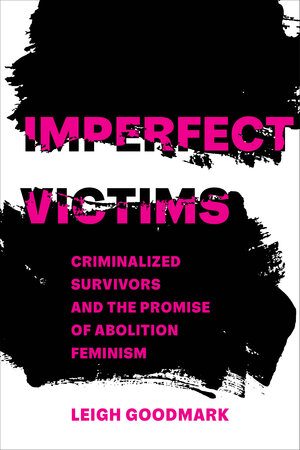By Leigh Goodmark, author of Imperfect Victims: Criminalized Survivors and the Promise of Abolition Feminism
Sally McNeil, like many of the people featured in my new book, Imperfect Victims: Criminalized Survivors and the Promise of Abolition Feminism, is an imperfect victim.
The subject of the Netflix hit series “Killer Sally,” McNeil was a 27-year-old Marine when she met her husband, Ray. The couple dominated armed forces bodybuilding competitions. In a video early in the series, viewers see Sally lifting the much larger, hugely muscled Ray on her shoulders from a squat position.
On Valentine’s Day 1995, Sally McNeil killed Ray after he strangled her to the point where she believed he would kill her. This was not the first time that Ray had assaulted or strangled Sally. But on this occasion, Sally McNeil took the sawed-off shotgun the couple kept in their bedroom and shot him twice, killing him.
Sally McNeil was charged with murder. Reviewing the police interview tapes with Sally McNeil, prosecutor Daniel Goldstein said, “I did not see her being the fearful battered woman she claimed to be.”
Goldstein is correct—Sally McNeil did not look like a fearful “battered woman.” She failed to conform to any of the stereotypes associated with that term: a woman who is weak, meek, passive, and does not fight back against her partner.
Indeed, Sally McNeil transgressed these norms in almost every way. She was a Marine, a branch of the armed services particularly noted for its machismo. She was a heavily muscled, physically strong woman, a champion bodybuilder. She was the primary breadwinner for the family, subsidizing her husband’s bodybuilding career. She wrestled men for money, selling access to her body to men who fetishized her strength. She brawled with neighbors, police, and the women her husband was dating without her consent during their marriage. She used “inappropriate” language. Her affect in talking to police about shooting her husband was flat—matter of fact, with few tears until she was told that her husband was dead. She physically fought with her husband, often because of his infidelity. As Goldstein asserts in “Killer Sally,” “a violent person can’t be a battered woman.”
But none of this changes the fact that Ray McNeil battered his wife. As strong as Sally McNeil was, Ray McNeil was much, much stronger. Sally McNeil inflicted no injuries on Ray McNeil before his murder. But military records document Ray McNeil’s abuse of his wife. A witness testified to seeing bruises on Sally. Ray broke Sally’s nose, and Sally’s daughter testified to hearing her mother being strangled the night of the murder. Sally feared for her life. She killed her husband because she feared for her life.
Sally McNeil, and thousands of people like her, have been convicted of crimes related to their own victimization. Criminalized survivors are convicted of killing their own partners, of committing crimes at the behest of or under duress from their partners, and of being involved with their partners’ crimes in some way.
But prosecutors like Goldstein regularly dismiss, belittle, or ignore criminalized survivors’ stories of victimization. They disregard evidence of abuse. They insist that something other than abuse—anger, jealousy, greed—motivated the survivor’s actions. Goldstein, for example, called Sally McNeil a “bully” and a “thug.” Once a survivor becomes a defendant, prosecutors seem unable to acknowledge the abuse that they have endured.
McNeil’s defense was that she shot her husband to save her own life. But jurors did not believe she had acted in self-defense—a common outcome for criminalized survivors. Self-defense requires that the person use only the amount of force necessary to protect themself from an immediate or imminent threat to their life. Prosecutors argue, and jurors often find, that the amount of force used was disproportionate to the threat posed—particularly when a weapon is involved—or that the threat to the survivor was not imminent. In the McNeil trial, that’s exactly what happened. As one juror explained, “there was no imminent danger—she just decided that she was going to end his life.” Sally McNeil was found guilty of second-degree murder and sentenced to 19 years to life in 1996. She was released in 2020.
During Sally McNeil’s trial, a newscaster asked, “Is she a strong woman or a victim?” What so many people refuse to see is that she can be both. And like other people who fail to conform to stereotypes about survivors of intimate partner violence, Sally McNeil paid dearly for that failure.
Imperfect Victims tells the stories of these survivors and argues that reforming the criminal legal system will not prevent their criminalization. Imperfect Victims calls for an abolition feminist approach to survivors, a politics and practice that understands the violence inherent in carceral systems, rejects punitive structures, and builds institutions that facilitate safety, health, and well-being. And while the goal is dismantling these systems altogether, it offers a number of policy proposals on the way to abolition. Abolition feminism opposes new criminal laws, even when those laws are marketed as making survivors safer. It embraces repealing laws that disproportionately harm survivors, like mandatory arrest and mandatory sentence laws. It rejects constructing prisons and jails, even when—especially when—those facilities are touted as trauma informed or gender-responsive. Ultimately, though, the only way to ensure that criminalized survivors are no longer punished by the criminal legal system is to eliminate that system. Abolition feminism can show us how.

